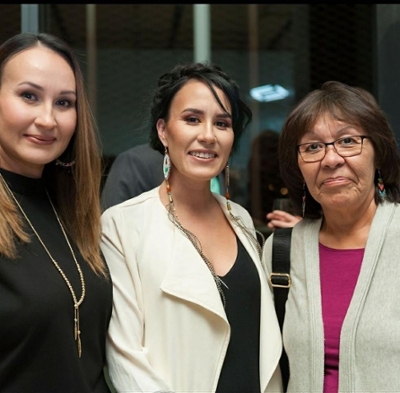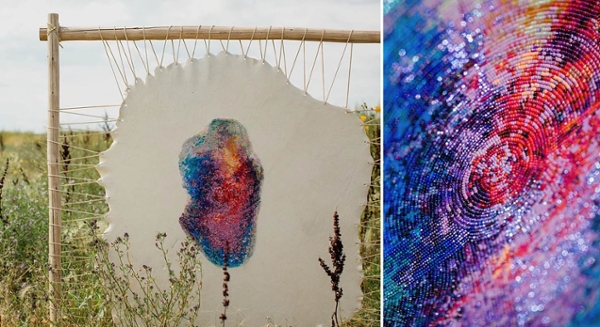
Threading the past into the present
When Catherine Blackburn (BFA’07) enrolled in the Studio Art program at the University of Saskatchewan, she had never taken a formal art class.
By Lindsay Royale
“I had the typical elementary art class experience, but nothing along the lines of learning to use a photography dark room or printmaking lab,” she explains. Arriving in Saskatoon with its bustling campus, Catherine set out to find her way—not only as an artist, but an individual.
Blackburn was born in Île-à-la-Crosse, Saskatchewan, and lived in the nearby community of Patuanak before relocating to the rural town of Choiceland, Saskatchewan. As a member of the English River First Nation, she felt displaced from her community after the move. “I didn’t get to build relationships with my extended family the same way as my cousins or even my older siblings. This shift resulted in me not learning the Dene language, creating another barrier of communication when visiting. The traditional Dene ways of life didn’t play a large role in my life,” she explains.
The U of S would expose Blackburn to a number of different art mediums, from painting to printmaking. As she began to create, themes of identity, culture and language began to emerge in her practice: she began exploring her history and heritage. “What started as a place of disconnect really evolved into a place of celebration,” says Blackburn. “I feel my voice has grown stronger, I am more confident in myself—not just as an artist—but as a representative of Aboriginal voice and experience.”
These days Blackburn’s kitchen table moonlights as a workspace for her art. Scattered across the wooden surface are bags of brightly-coloured beads, thimbles, scissors and containers of porcupine quills. With a needle in hand, Blackburn threads one miniscule bead after another, until her artwork takes form. “It can take anywhere between two to 500 hours to complete a piece depending on the size and complexity of the pattern,” she explains.
Blackburn’s dedication to the craft has not gone unnoticed. This year, she was presented the RBC Emerging Artist Award by the Saskatchewan Arts Board. The award recognizes an emerging Saskatchewan artist who demonstrates exceptional promise through early notable accomplishments. In addition to the prestigious title, Blackburn was awarded a cash prize. “I feel incredibly honoured. It is validation but, being the perfectionist that I am, it is also pressure. Prestige has its place, but to cultivate it in a way that is beneficial on a community level is a goal of mine.”

Since proclaiming herself as an artist, Blackburn has worked tirelessly to not only earn a living with her craft, but to share her own journey with others. By connecting with her heritage through family members’ experiences and traditions, as well as her own, she hopes that her art will be a catalyst for continued dialogue about the Indigenous experience in Canada. “After viewing my work, I hope people have a clearer understanding of how different and expansive the Canadian experience is and to be empathetic towards those experiences. I hope they walk away wanting to be involved in this discussion.”
For Blackburn, art has been a place where she has been able to find a voice. By merging traditional Dene practices with modern concepts, she is able to tell a story that uniquely hers. “As I get older and navigate my way through these feelings, my focus is no longer centered on the loss, but has evolved to appreciate my own perspectives and experiences. I have coveted those memories of the north and use them in making new ones as I connect the dots in my journey. It becomes a map of my growth and I can appreciate the ways in which traditions and culture have formed and inform my practice.”
Blackburn’s artwork can be viewed here.

